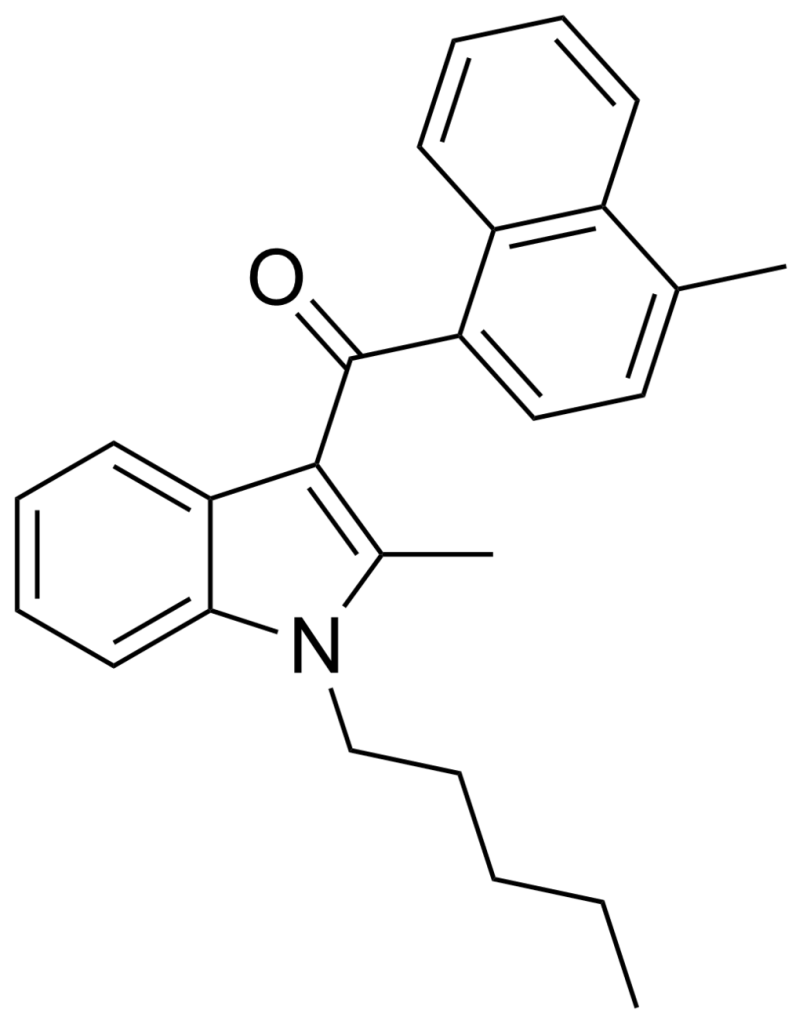Summary
JWH-149, a synthetic cannabimimetic compound, was initially identified by John W. Huffman. This substance is the N-pentyl analog of JWH-148. Notably, it demonstrates significant binding affinity for the CB2 receptor, with a Ki (inhibition constant) of approximately 0.73 ± 0.03 nM for this subtype. Additionally, it exhibits more than six times selectivity for CB2 over CB1 receptors.
In the United States, compounds like JWH-149, classified within the 3-(1-naphthyl)indole class and functioning as CB1 receptor agonists, are designated Schedule I Controlled Substances, indicating their illegal status under federal law.
| Identifiers | |
|---|---|
| IUPAC name | |
| CAS Number | 548461-82-1 |
|---|---|
| PubChem CID | 45267820 |
| ChemSpider | 24627235 |
| UNII | AWD731Y25Z |
| CompTox Dashboard (EPA) | DTXSID40203331 |
| Chemical and physical data | |
| Formula | C26H27NO |
| Molar mass | 369.508 g·mol−1 |

FAQ
1. What is JWH-149?
JWH-149 is a synthetic cannabimimetic compound that John W. Huffman initially discovered. It is the N-pentyl analog of JWH-148 and belongs to the 3-(1-naphthyl)indole class, known for its interactions with cannabinoid receptors.
2. How does JWH-149 work?
JWH-149 operates by binding to cannabinoid receptors in the body. It has a notable affinity for the CB2 receptor, making it a potential candidate for research into its effects on this subtype.
3. What is JWH-149’s selectivity for CB2 over CB1 receptors?
JWH-149 is moderately selective for the CB2 receptor, with a binding affinity (Ki) of approximately 0.73 ± 0.03 nM. It exhibits more than six times selectivity for the CB2 receptor over the CB1 subtype.
4. Is JWH-149 legal in the United States?
No, JWH-149 and similar compounds classified as CB1 receptor agonists within the 3-(1-naphthyl)indole class are designated as Schedule I Controlled Substances in the United States. This classification means they are illegal under federal law.
5. What are the potential effects of JWH-149?
The effects of JWH-149 can be similar to those of natural cannabinoids, such as altered mood and perception. However, the specific products and risks associated with its use are still the subject of research and concern.
6. Is JWH-149 used for medical purposes?
JWH-149 has not been approved for any medical applications. Its safety and efficacy for medical use have yet to be established through rigorous testing. For medical conditions, it is crucial to consult healthcare professionals and use approved medications.
7. Are there risks associated with JWH-149 use?
Yes, risks are associated with using JWH-149, including potential health risks and legal consequences. The use of synthetic cannabinoids can lead to unpredictable and harmful side effects, making it unsafe and discouraged.
8. Where can I find more information about JWH-149?
To learn more about JWH-149, consult reputable scientific literature and healthcare professionals. Always prioritize safety and adhere to local laws and regulations regarding controlled substances.
References
- Pioneering Cannabinoid Receptor Research (January 2005): In a groundbreaking study conducted by Huffman JW, Zengin G, Wu MJ, Lu J, Hynd G, Bushell K, and colleagues in January 2005, the structure-activity relationships of 1-alkyl-3-(1-naphthoyl)indoles were explored concerning cannabinoid CB(1) and CB(2) receptors. This research delved into the steric and electronic effects of naphthoyl substituents and paved the way for the development of novel highly selective CB(2) receptor agonists. These findings significantly contributed to our understanding of synthetic cannabinoids and their interactions with specific receptors.
- United States Controlled Substances Act (21 U.S.C. § 812): The United States Controlled Substances Act, as outlined in Section 21 U.S.C. § 812, establishes and categorizes controlled substances in the United States. This legislative framework is pivotal for regulating various substances, particularly those with the potential for psychoactive effects and misuse, ensuring legal control and safety.
